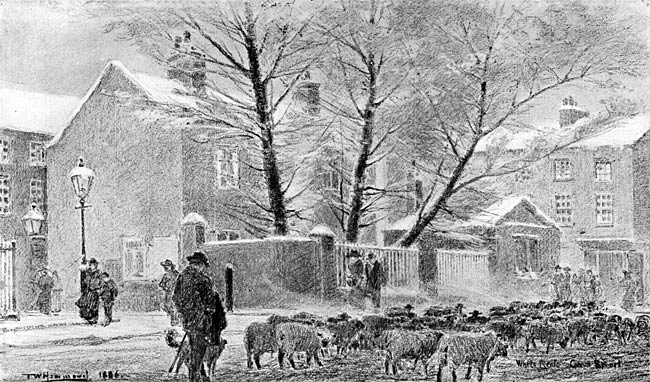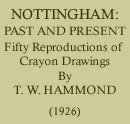< Previous | Contents | Next >
NOTTINGHAM PAST & PRESENT: NOTED BUILDINGS
THE WHITE RENTS, Leen Side, 1886

The White Rents were situated where the weighing machine now stands on Castle Boulevard at the end of Grey Friar Gate, and their memory is retained by the name of White Rent Street which is a short thoroughfare in that neighbourhood.
The history of these alms houses—now completely vanished—is interesting, and the reason for their curious name even more so: it appears that a certain William Gregory, Town Clerk of Nottingham, by a will dated 1613, left eleven tenements situated on the south side and near the bottom of Houndsgate for the benefit of the poor. By this will Gregory had made provision for the upkeep of these houses and the trust appears to have continued its work until 1788. Mr. Gregory appointed the Corporation of Nottingham as guardians of his charity but the Corporation divided the property into three equal shares and handed it over to the care of the churchwardens of the parishes of St. Mary, St. Peter and St. Nicholas'. Gradually the property fell into disrepair, became the resort of the lowest of the low—and a public nuisance. In 1788 it was sold and the proceeds of the sale were divided equally among the three parishes. The wardens of St. Peter's with their share bought a plot of ground in Broad Marsh upon which they erected a workhouse; the wardens of St. Mary's built twelve single-roomed dwellings on the north side of York Street; and the wardens of St. Nicholas' erected eight rooms—the subject of Mr. Hammond's drawing—for as many poor people of their parish.
Their strange name came about thus : Rents of Assize are established rents of a freeholder or copyholder, which cannot be varied; they are often spoken of as 'quit rents' because thereby the tenant goes free, or is quit of all other services; when these payments were made in silver, or white money, they were called 'white rents,' to differentiate them from the rents paid in grain or in work, which were called 'black rents.' The property left by Mr. Gregory was the last estate to pay quit rent to the Peverel family who were the lords of the manor in ancient days, and as this rent was paid in silver the property was known as the 'White Rents.'
